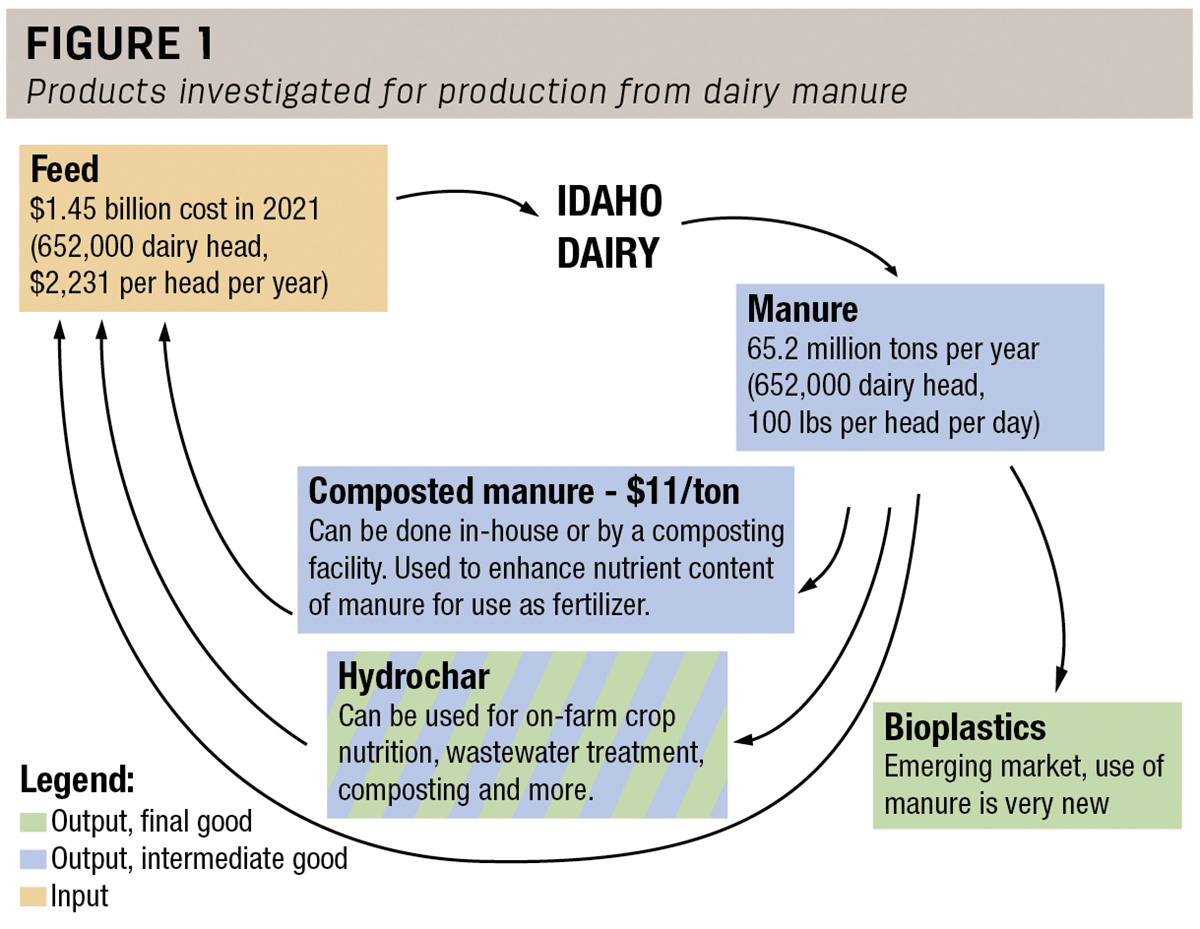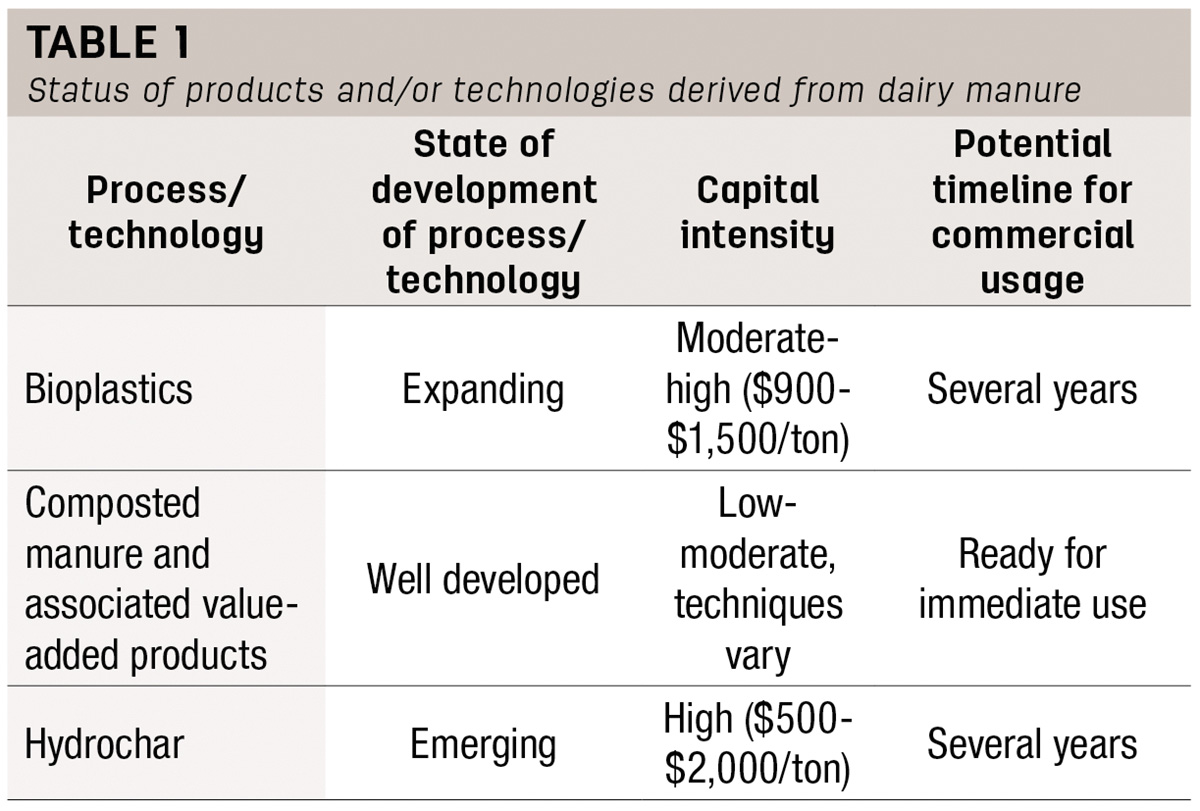Land-grant universities, including the University of Idaho (UI), have three main focuses: education, extension and research. When these areas meet, it allows for greater learning opportunities. One facet of the UI student experience that has distinct opportunity to boost learning in several of these focus areas is the completion of a “capstone” project. These projects are designed such that students work with industry professionals and/or businesses to complete a report and presentation on a topic or business issue that is important for the Idaho agricultural economy. This article was formed based on a capstone project implemented by the UI student and faculty authors that examined the potential for expanding the usage of dairy manure by businesses other than dairies (e.g., compost firms, crop farms) in the Magic Valley.
The objectives of the Idaho Sustainable Agriculture Initiative for Dairies (ISAID) project are to investigate and develop practices, processes and technologies that enhance the usability of dairy manure subcomponents for production of intermediate goods used in making final goods or final goods directly. Utilizing more dairy manure for production of other goods can potentially increase revenue for dairy farmers, reduce the reliance on synthetic fertilizers by local crop producers and lessen the risk of losses of manure-based nutrients and associated particulate matter into the environment.
Figure 1 shows several products that have been investigated for production from dairy manure by researchers at UI and others throughout the U.S. and the world. These include bioplastics, composted manure and associated value-added products (e.g., pellets), and hydrochar.

A description of each of these processes or products is as follows:
Bioplastics – Plastics originating from acids derived from biological sources, such as food waste, food processing biproducts and manure. Currently available bioplastics use a variety of bases, including starch, bacteria, soy, cellulose, lignin, as well as dairy cow manure. Some bioplastics are biodegradable, given the right environment, temperature and microbes.
Composted manure – Organic matter that undergoes decomposition with the proper heat, turning and moisture cycles. Numerous techniques exist for composting, ranging from formalized tracking to occasional turning. The composting process stabilizes the nitrogen in manure, but ammonia volatilizes in the process. Compost is used primarily for crop nutrients, either in replacement of synthetic fertilizer or as a soil amendment.
Hydrochar – A type of charcoal, or biological material, that is created by using the hydrothermal carbonization (HTC) process on slurry such as cow manure. Hydrochar can be used in composting, soil remediation, wastewater treatment, energy production and more. Existing research shows promising results for use of hydrochar for filtering phosphates from water.
Investigating the business potential of these processes and technologies is particularly important to the Magic Valley agricultural economy due to the high concentration of milk production and the associated substantial amount of dairy manure in the region. To illustrate, for the capstone project, the authors implemented an estimation of nutrient supply from manure, in the form of nitrogen, phosphorus and potassium, and the demand for these nutrients from crops grown in the region. The results showed that, for several counties, and especially Gooding County, the largest dairy-producing county in Idaho, the supply of nutrients from dairy manure exceeds that demanded by crops, with variation across the nutrients and counties. The evidence of surplus dairy manure-based nutrients implies that it is worthwhile to investigate more ways to utilize manure in an economically and environmentally sustainable manner.
In Table 1, we include each of the processes and/or technologies described and list their associated status regarding development of the industry, capital intensity and potential timeline for commercial usage by businesses in the dairy manure supply chain.

As stated in the table, business development and activity for composted manure and associated value-added products (e.g., pellets) is greater than is the case for hydrochar and bioplastics. Composting dairy manure does not require the same capital investments that other technologies require. Compost tracking and turning is performed by independent companies using readily available equipment and well-known practices. While composting dairy manure is widely practiced in Idaho and across the U.S., creation of value-added products such as manure pellets has mostly been done so far by companies in Europe and Asia.
Hydrochar production from dairy manure requires complex equipment, chemical reactions and precise physical parameters (temperature, time, presence of catalyst). Research and development of hydrochar seem to be accelerating, with new findings in published research expanding rapidly throughout 2021-23. Thus, equipment and process improvements for hydrochar production are likely to emerge in the years ahead.
The existing published research on bioplastics was implemented primarily by researchers in Europe and has been relatively less of a research focus among scientists in the U.S. One potential reason is because the production of bioplastics is currently more expensive than conventional plastic derived from fossil fuels. Existing economies of scale in the petroleum-based plastic industry make it faster and cheaper to produce large quantities of conventional plastics, rather than the smaller bioplastic batches that are achievable under current technology. However, as efficiency in bioplastic production (including that from dairy manure) improves, it is likely the market for these products will increasingly compete with petroleum-based plastics in production of a wide variety of products.
UI students and faculty in a variety of fields are currently investigating the scientific and commercial viability of the dairy manure-based processes and products discussed in this article, as well as others. We encourage you to keep updated on the progress of the ISAID project research and extension activities via the project website. You can also keep updated on the project on social media via the following platforms and pages: Instagram: @uofiisaid, Facebook: search “University of Idaho ISAID grant” and Twitter: @uofiisaid.
Katelyn Hettinga and Daelas Zieber contributed to this article. Hettinga graduated from the University of Idaho in the spring of 2023 with a dual major in agricultural economics – applied economics and political science. Zieber graduated from the University of Idaho in the spring of 2023 with a degree in agricultural economics with an emphasis in economics and political science.
This effort was undertaken as part of the UI grant project funded under the USDA National Institute of Food and Agriculture Sustainable Agricultural Systems Program, which is now known as the ID Sustainable Agriculture Initiative for Dairy (ISAID). The ISAID project is active from 2020-25, so project activities implemented by faculty and students are starting to ramp up.
References omitted but are available upon request by sending an email to the editor.


.jpg?t=1687979285&width=640)


.jpg?height=auto&t=1713304395&width=285)


